Texas may be home to the largest pair of cowboy boots but does it also have the deepest lake? You may think of Texas as a dry desert state but actually, only 10 percent of the state is officially desert. So there are many lakes dotting the landscape of Texas. Some are large recreational lakes while others are smaller swimming holes. Many of the lakes in Texas are along rivers that share borders like the Toledo Bend Reservoir on the Texas/Louisiana border and Lake Amistad on the Texas/Mexico border, while other lakes are entirely in the state. Let’s look at all the lakes in Texas to discover which one is the deepest lake in Texas.
What Is the Deepest Lake in Texas?
The deepest lake in Texas is Lake Amistad. The Amistad Reservoir is one of the lakes in Texas that borders another country, Mexico. It is located on the mighty Rio Grande River at the Amistad Dam. The Devil’s River flows into Lake Amistad from the north to add to this 64,900-acre lake. The Amistad National Recreation Area which covers 57,292 acres of land is on the northern side of the lake providing a habitat for a variety of animals including 50 documented species of fish!
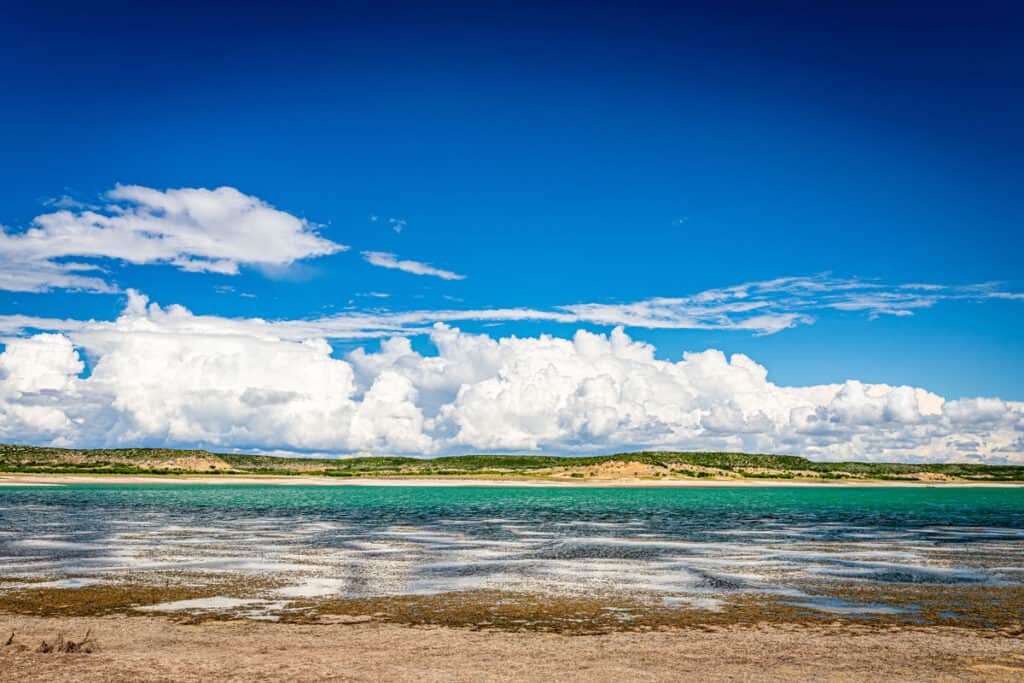
Lake Amistad is the deepest lake in Texas.
©iStock.com/Different_Brian
How Deep Is the Deepest Lake in Texas?
The deepest lake in Texas is 217 feet deep. Lake Amistad was formed when the Amistad Dam was constructed on the Rio Grande in a joint effort between the US and Mexico. According to the National Park Service, the dam cost $125 million dollars to build (in 1969 dollars). The cost was split between the US and Mexico with the US contributing 56.2% of the cost and Mexico covering the rest (43.8%). The completed dam is used for power generation and flood control and it created a good-sized lake in the middle of the desert that can be enjoyed for boating, fishing, and scuba diving.
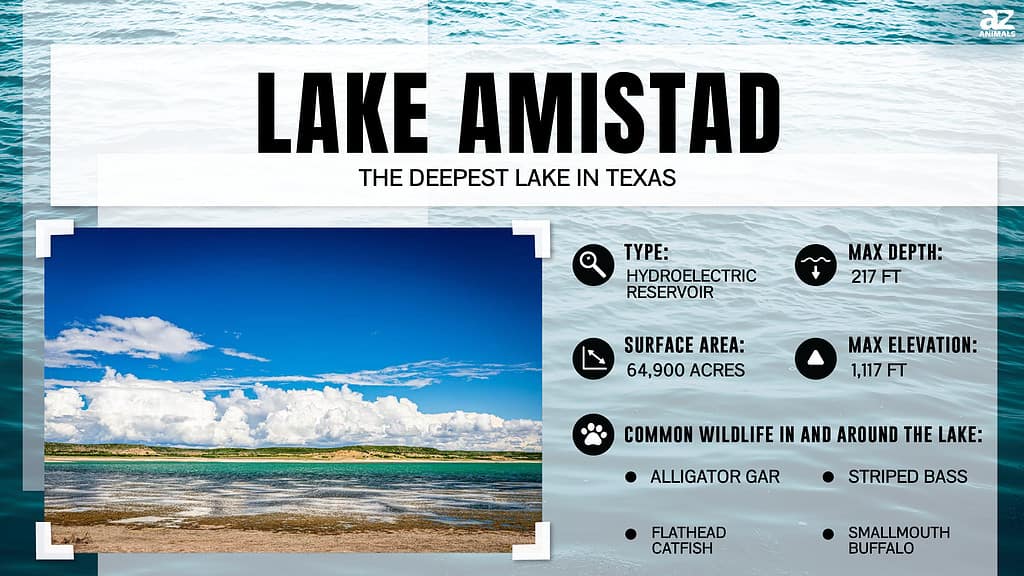
Where is Lake Amistad Located on a Map?
Lake Amistad is located in the southern part of Texas, near the border with Mexico. Specifically, it can be found in Val Verde County and approximately 12 miles northwest of Del Rio. To get to Lake Amistad, travelers can take US Highway 90 or US Highway 277 from San Antonio or El Paso. From there, they will need to head towards the city of Del Rio before continuing on to State Park Road 63, which leads directly to the lake. On a map, Lake Amistad can be located by searching for Val Verde County and then focusing on the area just north of Ciudad Acuña in Mexico, where a large body of water is visible.
How Is the Fishing on Lake Amistad?
The fishing on Lake Amistad is excellent, especially for bass and catfish. The waters of Lake Amistad are filled with hydrilla and pondweed in areas making it a great habitat for a variety of fish. With all of the tributaries and twists and turns, it is worth taking your fishing boat out to attempt to find the perfect fishing hole. Other fish in Lake Amistad include shad, gar, crappie, sunfish, and drum.
Do Fish Like Deep Water?
Some fish prefer shallower water around lots of vegetation while others will hide in the deeper spots of the lake, especially in clear-water lakes. There is a lot of fluctuation throughout the seasons and availability of food. “Deep” can be 30 feet down in a smaller lake whereas “deep” can be 1,000 feet or more in other lakes. While some fish are bottom-feeders like carp, they are not likely going to be found bottom-feeding at the deepest point of any lake. Carp, for example, are omnivorous and rely on eating plants and vegetation which is more abundant in shallower waters.
Are There Any State Fishing Records from Lake Amistad?
There are not any rod and reel records from Amistad but there was a massive alligator gar that was caught by Darren Carr with a spear gun, on August 3, 2018. The alligator gar weighed in at 235 pounds and was 95 inches long (that’s an inch shy of 8 feet!).
A few other “All-Tackle Records for Amistad” include:
- Smallmouth buffalo: 70 pounds, Duane M. Goettsch, Nov 25, 2013, Rod and Reel
- Striped bass: 45 pounds, Tom J. Reavis, May 14, 1990, Rod and Reel
- Flathead catfish: 39.40 pounds, Jordan Bavousett, Oct 21, 2007, Trotline
What Is the Deepest Lake Entirely in the State of Texas?
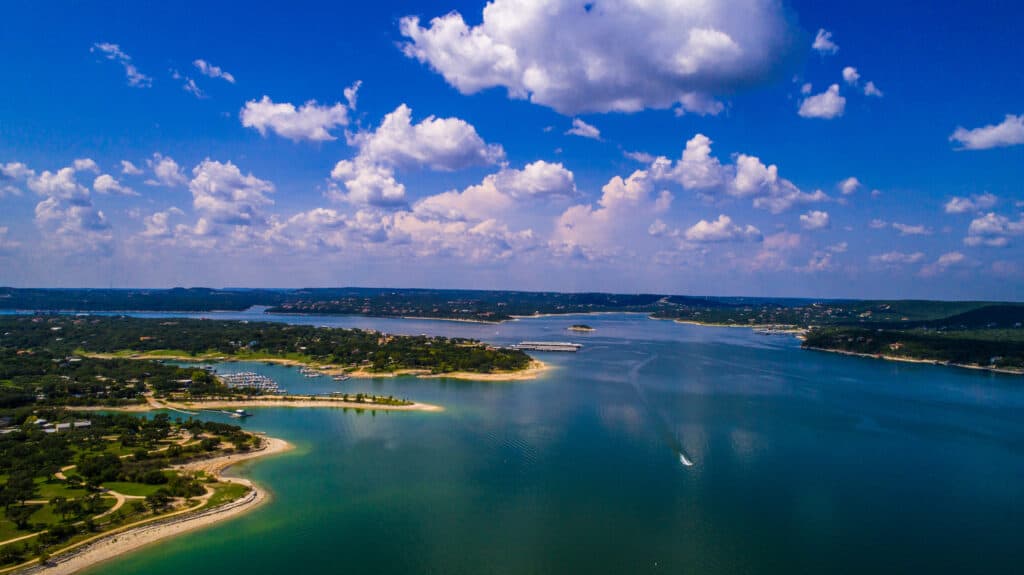
Lake Travis is the deepest lake in Texas.
©Roschetzky Photography/Shutterstock.com
The deepest lake entirely in the borders of Texas is Lake Travis. This popular recreational lake is on the Colorado River just northwest of downtown Austin. The suburban town of Lake Travis is built up around the lake with resorts, restaurants, homes, and parks all along the shore. Both residents and visitors enjoy boating, sailing, swimming, jet skiing, kayaking and fishing, and more on Lake Travis.
How Deep Is the Deepest Lake Entirely in the State of Texas?
The deepest lake entirely in Texas is 210 feet deep. That is the equivalent of standing in the end zone and looking down to the 30-yard line towards the opposing team, about 70 yards. The water levels in lakes obviously fluctuate, and the Texas Wildlife and Parks has the deepest spot on Lake Travis listed at 190 feet although the lake is known to fluctuate greatly.
How Is the Fishing on Lake Travis?
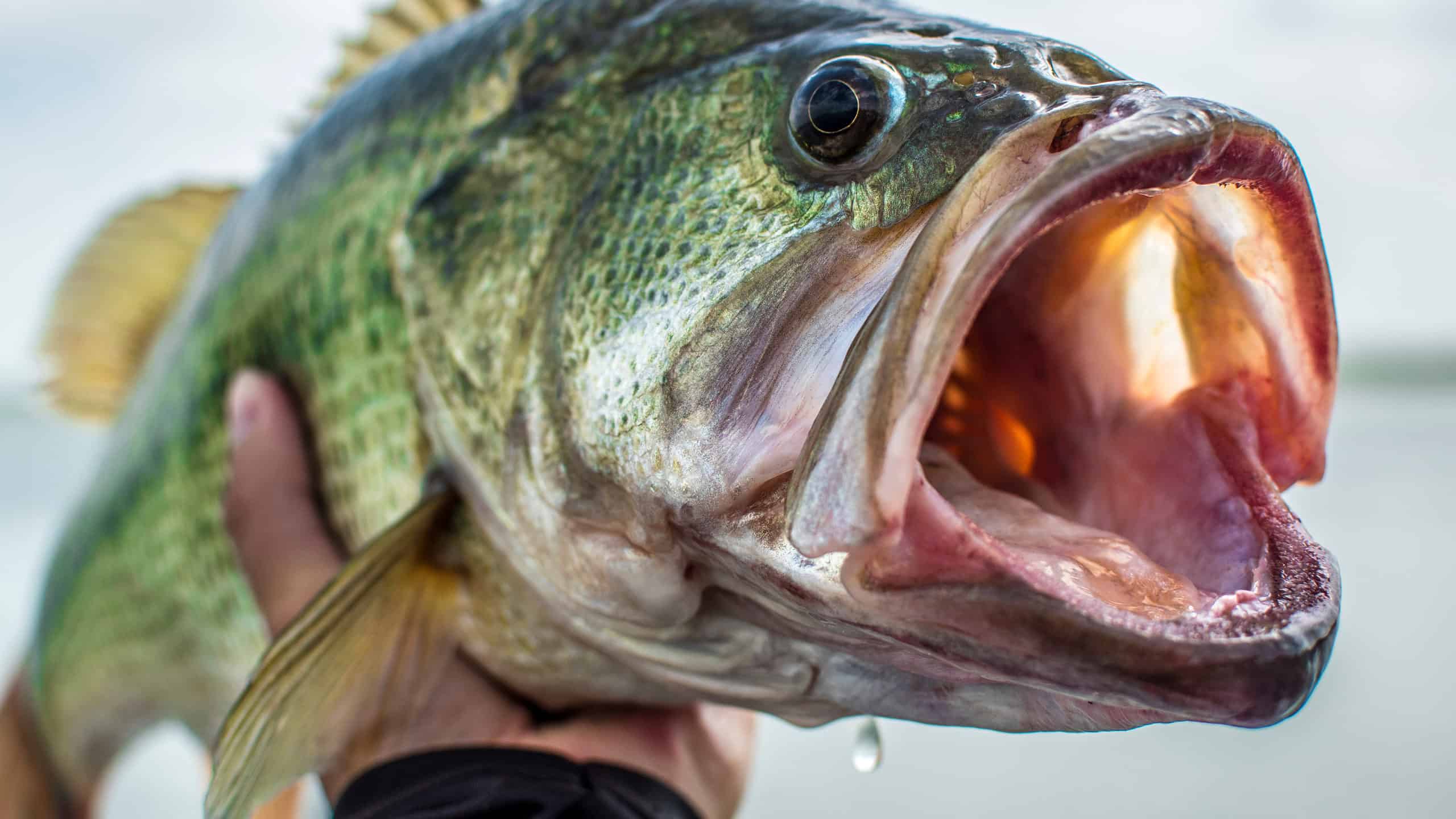
Big Largemouth Bass
©Pierre Rebollar/Shutterstock.com
The fishing is great on Lake Travis with largemouth bass, Guadalupe bass, white bass, sunfish, and catfish all being reeled in regularly. Largemouth bass is the most abundant but not necessarily the largest.
Are There Any State Fishing Records from Lake Travis?
Yes! There is one rod and reel record-breaking fish that was pulled from Lake Travis, just recently as well. On May 25, 2021, Keller Colton Shaw caught the largest Hybrid Tilapia. In general Hybrid Tilapia are not huge fish, nothing like the record-breaking blue catfish that weighed 121.50 pounds, but for a hybrid tilapia it was the biggest. Shaw’s catch weighed in at 5.78 pounds and was 19.50 inches long (about a foot-and-a-half).

Around Lake Travis, you can find axis deer,
antelopes
, and Rio Grande turkeys.
©iStock.com/Alberto Carrera
What Parks Are on Lake Travis?
Mansfield Dam is a large park on the southwest corner of the lake. The park offers a swimming cove, boat ramp, and an underwater dive park for Scuba divers. The dive park has sunken boats, old dam construction materials, and four platforms at different depths. There are campsites available for scuba divers as well if you want to make a weekend out of it.
Bob Wentz Park is on the peninsula on the eastern shore and is popular for windsurfing and has a sandy beach. Tom Hughes is another smaller park on the southeast edge of the lake. It does not have a flat sandy beach but instead provides some bouldering with primitive trails leading down the steep rocky terrain. Making it to the bottom is rewarded with a small swimming area, so bit of an adventure.
How Do Lake Amistad and Lake Travis Compare to the Deepest Lake in the US?
The deepest lake in the US is Crater Lake in Oregon. At the deepest point, Crater Lake is 1,943 feet deep. Whoa! At 217 feet and 210 feet respectively, Lake Amistad and Lake Travis don’t seem that impressive. It is a little more than 1/3 mile deep and sits at the top of a collapsed volcano. Crater Lake National Park is managed by the National Park Service. Crater Lake does not have any rivers, streams, or tributaries running into it so it is completely rain-/snow-fed. That is what makes it the crystal blue that it is.
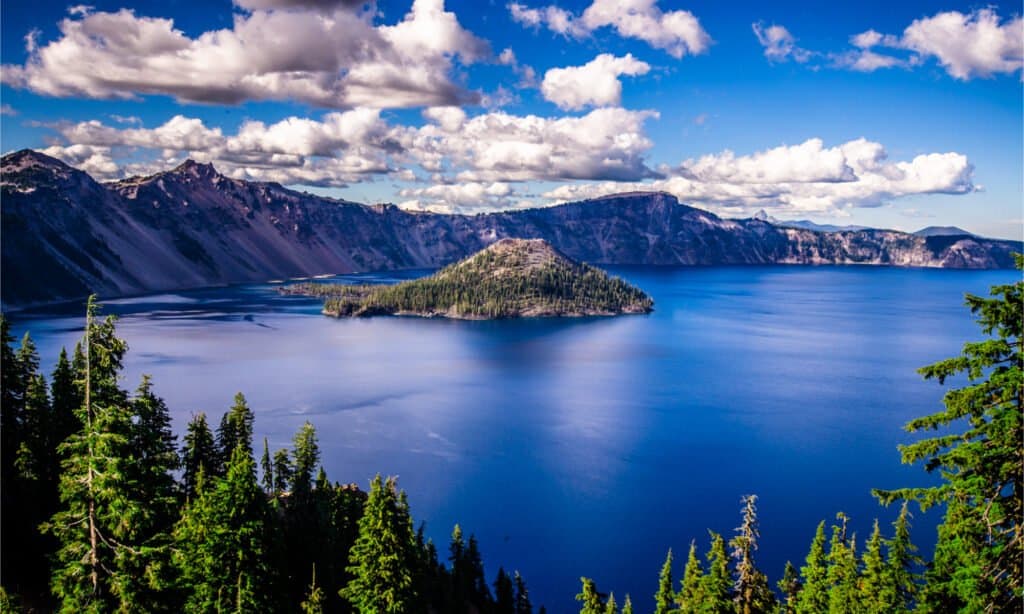
The deepest lake in the U.S. is Crater Lake in Oregon. At the deepest point, Crater Lake is 1,943 feet deep. Whoa!
©Pung/Shutterstock.com
Can You Scuba Dive in Crater Lake?
No. Scuba gear and snorkeling gear are not allowed in the lake. The National Park Service has set up several guidelines to protect the water clarity of Crater Lake and to protect from introducing invasive species to the lake. While you can hike down to the water’s edge along the Cleetwood Clove Trail, you cannot bring in a kayak, canoe, inner tube, wet suit, or waders. You are allowed to take a dip in the lake but remember it is extremely cold, even in the summer.
The photo featured at the top of this post is © Alexander Imperial/Shutterstock.com
Sources
- Texas Parks and Wildlife, Available here: https://tpwd.texas.gov/fishboat/fish/recreational/lakes/travis/
- Texas Parks and Wildlife, Available here: https://tpwd.texas.gov/fishboat/fish/recreational/lakes/toledo_bend/
- Travis County Parks, Texas, Available here: https://parks.traviscountytx.gov/parks/tom-hughes
- Travis County Parks, Texas, Available here: https://parks.traviscountytx.gov/parks/mansfield-dam
- National Park Service, Crater Lake, Available here: https://www.nps.gov/crla/faqs.htm
FAQs (Frequently Asked Questions)
How deep is the deepest point on Lake Travis?
The water levels in lakes obviously fluctuate, and the Texas Wildlife and Parks has the deepest spot on Lake Travis listed at 190 feet, but that is still deeper than the next deepest lake.
Where is the deepest lake in the US?
The deepest lake in the US is Crater Lake in Oregon. At the deepest point, Crater Lake is 1,943 feet deep.
Thank you for reading! Have some feedback for us? Contact the AZ Animals editorial team.






